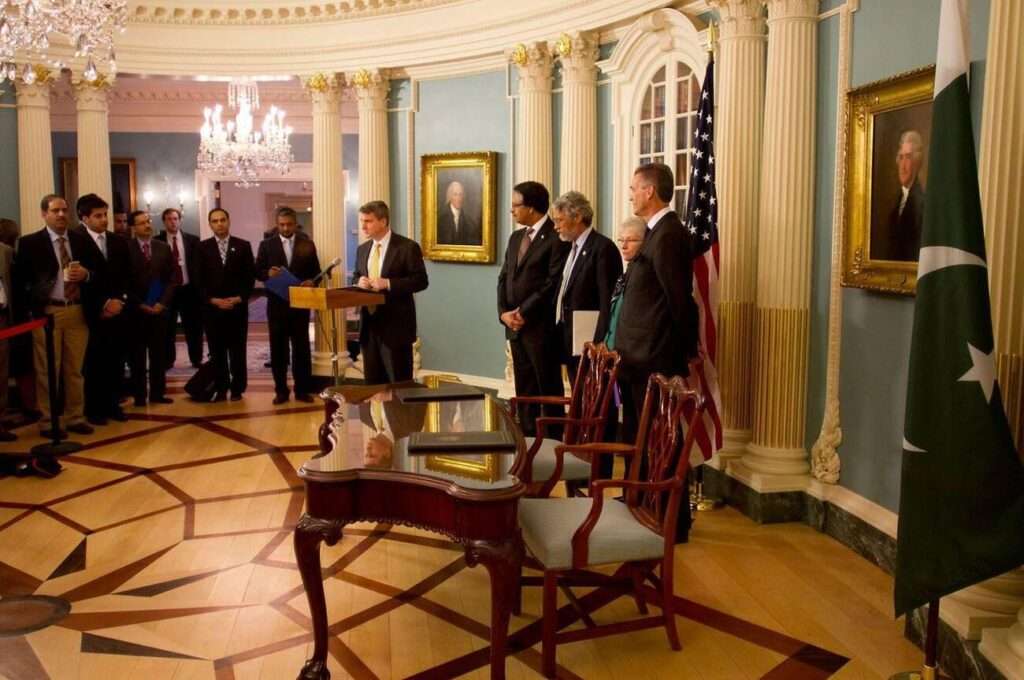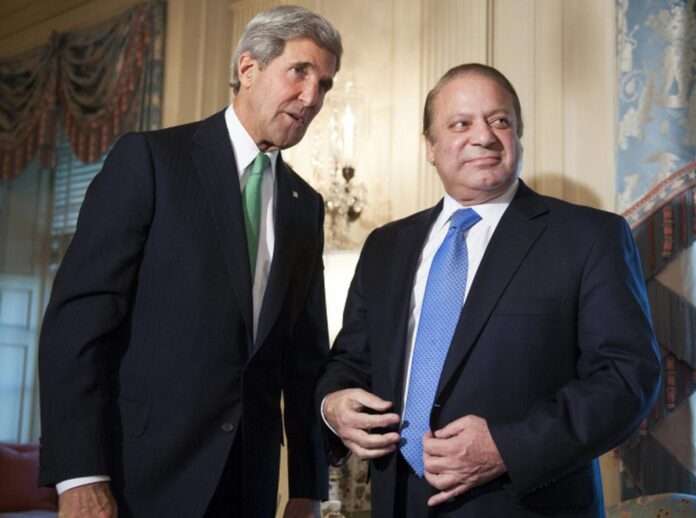Prime Minister Nawaz Sharif just completed his official visit to Washington where he met President US President Barack Obama, Vice-President Joe Biden, Secretary of State John Kerry and other top officials.
A long range of issues relating to enduring bilateral relations, economic integration, science and technology cooperation, trade and commerce, drone attacks, regional security and the last but not the least, foreign direct investments were thoroughly discussed. Prime Minister courageously raised the issue of drone attacks and termed its counterproductive in the ongoing war against terrorism. Economic integration and further strengthening of bilateral trade and commerce ties were the main areas of attraction of the Prime Minister Sharif recent visit to USA.
Salient Features of Joint Statement
1. Enduring Pak-US Partnership
Both countries committed to strengthen Pak-US relations and advance shared interests in a stable, secure, and prosperous Pakistan and region. They expressed their persuasion that an enduring Pak-US partnership is vital to regional and international security and recognized their shared interest in Pakistan’s economic growth and development, regional stability, and mutually determined measures to counter terrorism.
2. Resumption of Strategic Dialogue
Both sides welcomed the resumption of the Pak-US Strategic Dialogue and reaffirmed its importance as the suitable framework for guiding the bilateral relationship. They also decided on the strategic priorities for the five working groups including: a) Law Enforcement and Counterterrorism; b) Economics and Finance; c) Energy; d) Security, Strategic Stability, and Non-Proliferation; and e) the Defence Consultative Group.
3. Pakistan’s Efforts for Economic Growth and Energy Security
Prime Minister Sharif strongly highlighted his government’s efforts for economic growth, energy security, social development, and good governance. He thanked President Obama for the important contribution the United States has made in supporting Pakistan’s development efforts, including through the Enhanced Partnership with Pakistan Act of 2009. The leaders discussed the prime minister’s deep commitment to increasing economic growth in Pakistan and to taking the steps necessary to put Pakistan on a path of long-term economic growth and stability. President Obama reiterated US support for ongoing programmes to strengthen Pakistan’s economy and increased agricultural productivity.
4. Energy Cooperation
The leaders emphasized that both sides should work together on a range of options to enable Pakistan to overcome its energy deficiencies and that both sides will hold further discussions in the working groups on Energy and Security, Strategic Stability, and Non-Proliferation. Moreover, President Obama noted that US assistance in the energy sector has added over 1,000 megawatts of power to Pakistan’s national grid, helping over 16 million Pakistanis. Prime Minister Sharif expressed appreciation for US assistance toward the construction and rehabilitation of Gomal Zam, Satpara, Mangla, and Tarbela dams and the modernization of Guddu, Jamshoro, and Muzaffargarh power plants, and the leaders highlighted the recent Overseas Private Investment Corporation (OPIC) loan for private sector wind development in Sindh.
5. Science and Technology Cooperation
Both leaders expressed satisfaction at the implementation of the 2003 Agreement on Science and Technology Cooperation between the United States and Pakistan and acknowledging its significance in promoting a decade of intensified cooperation between the two countries, the two leaders decided to extend the agreement through 2018.
6. Strengthening of Educational Ties
Cooperation in high-quality education programmes was also discussed. President Obama reiterated that US assistance for education in Pakistan has built or rehabilitated over 600 schools, provided 12,000 university scholarships to Pakistani students, trained more than 10,000 teachers and school administrators, and provided more US-funded scholarships under the prestigious Fulbright programme in Pakistan than anywhere else in the world. These investments help prepare Pakistan’s younger generation to enter the job market and become leaders in their country and communities.
7. Military Engagements
Both sides expressed satisfaction on their military engagements including recent military cooperation exercises, and consultations on regional security. The two leaders noted with satisfaction that the Ground Lines of Communication (GLOCs) are facilitating the movement of US and International Security Assistance Force (ISAF) cargo through Pakistan. Prime Minister Sharif conveyed appreciation for US security assistance in support of Pakistan’s counterterrorism, counterinsurgency, counternarcotics, and maritime security operations and expressed hope of broadening bilateral defense cooperation in areas that serve mutual interest.
8. Counter-Terrorism
Both President Obama and Prime Minister Sharif condemned terrorism in all its forms and manifestations. The prime minister shared his perspective on effective counterterrorism cooperation to achieve the mutual objective of defeating terrorism.
President Obama and Prime Minister Sharif emphasized that nuclear terrorism is one of the most challenging threats to international security. President Obama appreciated Pakistan’s constructive engagement with the Nuclear Security Summit process and its cooperation with the International Atomic Energy Agency and other international forums, while acknowledging Pakistan’s efforts to improve its strategic trade controls and enhance its engagement with multilateral export regimes.
9. Regional Cooperation for Peace and Harmony
Both leaders agreed to jointly work for the regional peace and harmony. US appreciated Pakistan’s positive role in the ongoing dialogue with the Taliban within the country and also in Afghanistan.

Economic Bounties
a. Science and Technology Cooperation Agreement
During Prime Minister recent visit to US the US State Department announced the two countries signed a five-year extension of the US–Pakistan Science and Technology Cooperation Agreement. State Department’s Assistant Secretary for Oceans and International Environmental and Scientific Affairs (OES), Dr. Kerri-Ann Jones and Pakistani Foreign Secretary, Jalil Abbas Jilani signed the agreement to expand relations between the US and Pakistani scientific and technological communities, and were joined by the White House Office of Science and Technology Policy Director, John P. Holdren.
Multiplier Effects
Since its inception in 2003, this agreement has provided a framework to strengthen scientific, technological, and engineering capabilities for both our countries, helping foster mutual prosperity and economic growth. Under the auspices of the US–Pakistan agreement, our governments have jointly funded nearly $30 million worth of collaborative research projects through the US–Pakistan Science and Technology Cooperation Program.
In total, the program has supported 83 cooperative research projects between the US and Pakistani researchers in food security, public health, earth sciences and disaster management, engineering, water, energy, materials science, information technology, and ethics.
A number of US project-scientists are of Pakistani origin, highlighting the Pakistani-American diaspora’s role in promoting research-collaboration. Through this collaboration, over 10,000 Pakistanis have received training, and over 100 Pakistanis have made exchange-visits to the United States, a significant portion of which have been women or girls.
b. Release of $ 1.6 billion Assistance
The United States released $1.6 billion in aid to Pakistan, boosting a flow of assistance that slowed in recent years amid a downturn in relations. The bulk of the funding is made up of $1.38 billion in military. The rest is $260.5 million in civilian aid. “The $260.5 million in civilian assistance is part of the total $959.5 million in FY2012 civilian assistance to be notified, because much of the civilian assistance continued unaffected during the slowdown.
c. Prospective US Investments
During the different meetings it was decided that both countries would be engaged in a range of initiatives in the coming months to help bolster cooperation in trade, investment and energy sectors. The Pakistan-US Working Group on Energy will meet in Houston and Washington in November to discuss ways to expand cooperation. Under another initiative, the United States would invite Pakistani businessmen and send ‘buyers mission’ to spur trade prospects. Moreover, World Bank has agreed to finance the Dasu power project.
Historic Context
According to an official figure Pakistan has received $25.9 billion from the US during the past decade (2002-2012) in shape of all accounts The US has so far committed $1.164 billion for FY14 including $398 million for security-related expenditures and $766 million for the Economic Support Fund (ESF). It also includes $10.687 billion on account of reimbursement of Coalition Support Fund (CSF) payments, which cannot be defined as financial assistance in accordance with any standard because these expenditures were incurred by the Pakistan military in its attempts to flush out supporters of Taliban and then reimbursed by Washington.
According to a document prepared by the US Congressional Research Service in collaboration with the departments of state, defence, agriculture and USAID, Pakistan received $17.226 billion for security related expenditures while total economic related assistance stood at $8.686 billion since 2002.
Pakistan received $312 million in the shape of the National Defence Authorisation Act (NDAA) under section 1206 to provide global training and equipment. The US also provided $265 million for a Counternarcotics Fund (CN), $2.751 billion in shape of Foreign Military Financing (FMF), $27 million for International Military Education and Training (IMET), $717 million for International Narcotics Control and Law Enforcement (INCLF), $115 million for Non-Proliferation, Anti Terrorism, Demining and Related (majority for anti terrorism assistance) and $2.352 billion for Pakistan Counterinsurgency Fund (PCF)/ Counterinsurgency Capacity Fund (PCCF).

The US provided $5.687 billion out of the $10.687 billion during the Musharraf regime from 2002 to 2007. When the PPP-led government assumed power in 2008, the US reimbursed $1.019 billion in FY08, $685 million in FY09, $1.499 billion in FY10, $1.118 billion in FY11 and $688 million in FY12. The reimbursement for FY13 and FY14 is not yet fully known.
On account of total economic assistance worth $8.686 billion during the last one decade, the documents showed that USA provided $249 million for Child Survival and Health, $286 million for Development Assistance (DA), $6.610 billion for Economic Support Funds (ESF), $572 million for Food Aid, $17 million for Human Rights and Democracy Funds (HRDF), $704 million for International Disaster Assistance (IDA) and $248 million for Migration and Refugee Assistance (MRA) from 2002 to 2012.
A majority of the total economic assistance funds were received by Pakistan during the tenure of a democratically elected government. During the tenure of the Musharraf regime from 2002 to 2007, Pakistan received $2.033 billion in shape of Economic Support Fund while the country received $347 million in FY08, $1.114 billion in FY09, $1.292 billion in FY10, $919 million in FY11 and $905 million in FY12.
The Karachi stock market witnessed a massive gain of around 4.0 percent during the Prime Minister Nawaz Sharif’s US visit which created positive atmosphere at local bourse resulting in huge foreign inflow of $31 million. The Karachi Stock Exchange (KSE) 100-share index gained 845.81 points or 3.91 percent during the outgoing week to close at 22,445.59 points as compared with 21,599.78 points of the previous week.
Concluding Remarks
Although every country has its own socio-economic, geo-politics and geo-strategic vested interests but recent visit of the Prime Minister succeeded to achieve some convergences between the two countries. Nevertheless, controversies have been minimized. Commitments to have enduring Pak-US bilateral relations are the ultimate victor.
Energy security, economic integration, regional peace and cooperation in science and technology would further strengthen the Pak-US bilateral relations. Mutual military cooperation has strategic implications which would be used for any threat associated to terrorism, extremism and misadventures.
In net-shell too much was on stakes. From Pakistan side hopes were high for greater inflows of the US foreign investments, joint ventures and trade. US side also presented its list of preferences, pledges and persuasions. However, the nitty-gritty of the present interaction and those to follow should not be mistaken. It was giant show of commercial diplomacy, soft image projection, conflict resolution and above all securing greater economic bounties and markets.




